Different types of devotees of Lord Vishnu (Krishna / Rama / Hari) | Different types of devotions (Vishnu / Krishna / Rama) (Hinduism)
Namaste friends, how are you doing today? Welcome to #BhagavanBhakthi website / blog.
Bhagavan Lord Sri Vishnu (Krishna) (Rama) blessings to you and your family!
In this website / blog, you will always learn about #Hinduism #Sanskrit language.
Also subscribe to my YouTube channel from this link #BhagavanBhakthi to view videos about #Hinduism #Sanskrit language.
Just before going to “Different types of devotees of Lord Vishnu (Krishna / Rama / Hari) | Different types of devotions (Vishnu / Krishna / Rama) (Hinduism)“, let us have some brief information.
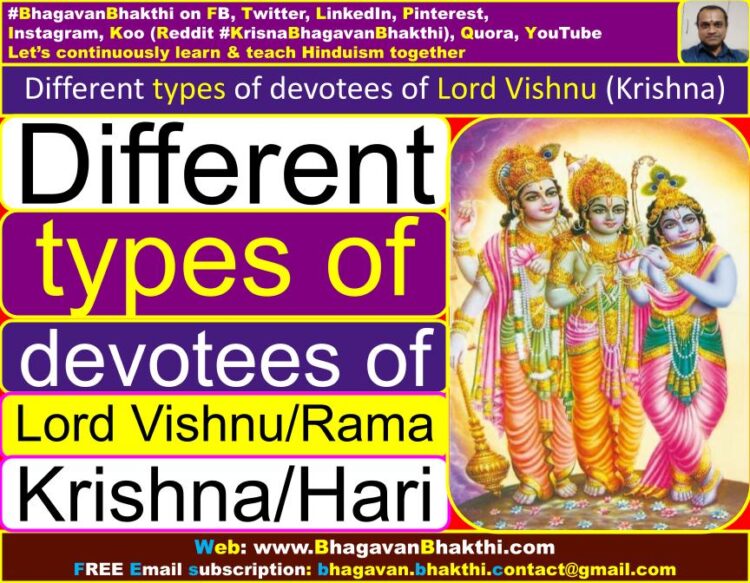
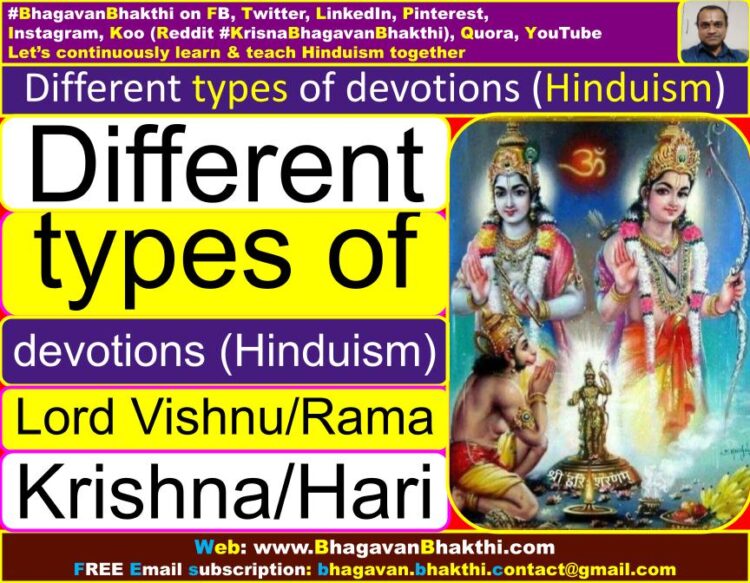
Lord Sri Vishnu delivers humans from all evil. The fruits of all actions should be vested with Lord Sri Vishnu.
Devotion to Lord Sri Vishnu is of paramount importance, but there are different types of devotions towards Lord Sri Vishnu.
The three basic elements (gunas) (qualities) are Sattvika, Rajasika and Tamasika. Sattvika guna is holy and pure, Rajasika guna is passionate and Tamasika guna is torpid.
Thus Sattvika guna is superior Rajasika guna is medium and Tamasika guna is inferior.

Above mentioned three gunas are present in everyone and everything. But what differentiates is the proportion that is present in particular human or in an item.
The reciprocity of these gunas determines the character of someone or something, of nature and also determines the progress of life.
One of Bhagavan Sri Vishnu name is known as ‘Nirguna’. Here Nirguna doesn’t mean he doesn’t has any gunas (qualities).
But, the real and correct meaning as per Hinduism is that, Lord Sri Vishnu is free of all the three gunas (qualities) (elements), that is:
Sattvika, Rajasika and Tamasika. All these three gunas doesn’t apply to Bhagavan Sri Vishnu as he is called ‘mukta’.
Here ‘mukta’ means, independent or completely free. Thus Nirguna means, Lord Sri Vishnu is not at all dependent on three gunas.
Lord Sri Vishnu is called ‘guna-paripurna’ (गुण-परिपूर्ण / guṇa-paripūrṇa), that is, he has unlimited gunas (qualities). Until today no one has the counting of his gunas (qualities).
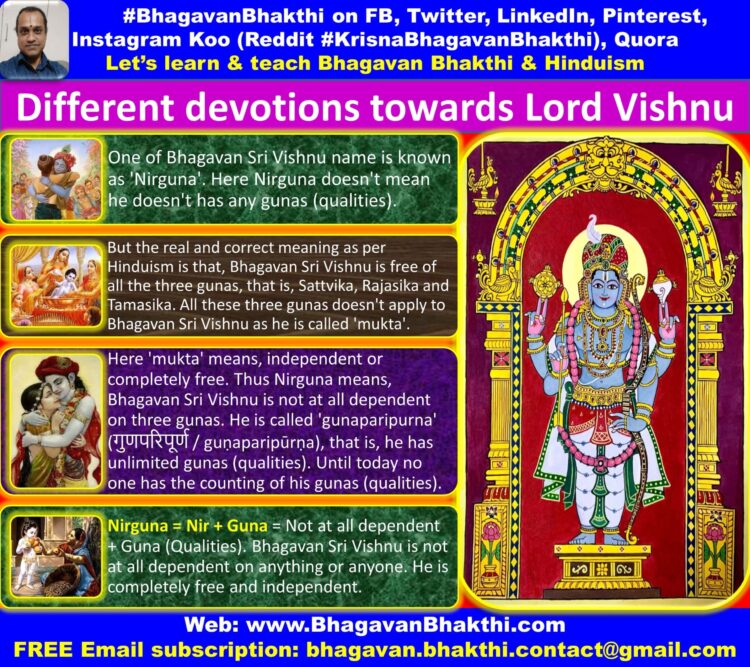
Nirguna meaning = Nir + Guna = Not at all dependent + Guna (Qualities). Lord Sri Vishnu is not at all dependent on anything or anyone. He is completely free and independent.
Different types of devotees of Lord Vishnu (Krishna / Rama / Hari) are as given below:
Different types of devotions (Vishnu / Krishna / Rama) (Hinduism) are as given below:
adhama-tamas | madhyama-tamasa | uttama-tamasa | adhama-rajasa | madhyama-rajasa | uttama-rajasa | adhama-sattvika | madhyama-sattvika | uttama-sattvika | uttamottama Bhakti |
Different types of devotees of Lord Vishnu (Krishna / Rama / Hari) meaning is as given below:
Different types of devotions (Vishnu / Krishna / Rama) (Hinduism) meaning is as given below:
1. adhama-tamas : A person who prays to Bhagavan Lord Sri Vishnu for someone else’s destruction is called as adhama-tamas.
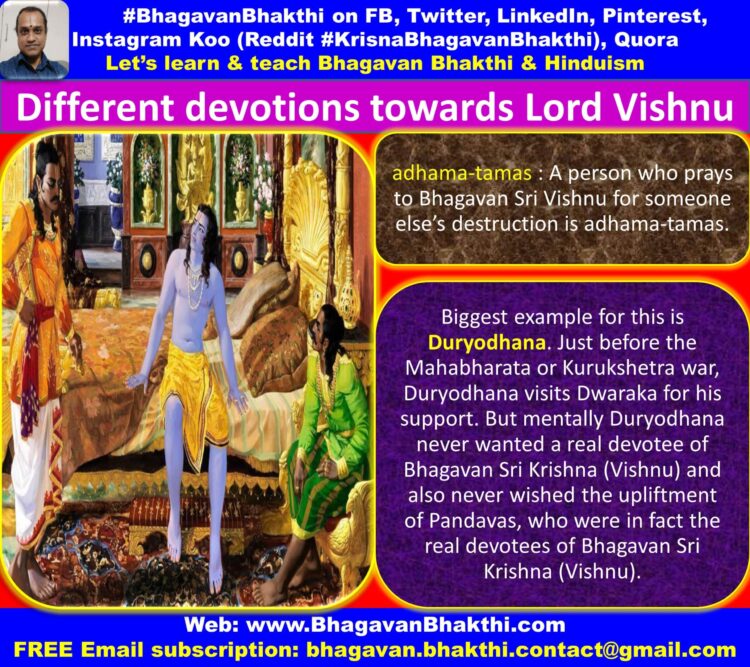
Biggest example for this is Duryodhana. Just before the Mahabharata or Kurukshetra war, Duryodhana visits Dwaraka (Dwarka) for his need of support.
But mentally Duryodhana never wanted to be a real devotee of Bhagavan Lord Sri Krishna (Vishnu) and also never wished the upliftment of Pandavas, who were in fact the real devotees of Bhagavan Sri Krishna (Vishnu).
2. madhyama-tamasa : A devotee who makes a pretense of praying to Lord Sri Vishnu is called as madhyama-tamasa.
Here, one of the best examples is Shakuni. He always pretended to be a devotee of Lord Sri Krishna. But inside (from heart and soul), Shakuni was always against Lord Sri Krishna, Yadavas and Pandavas.
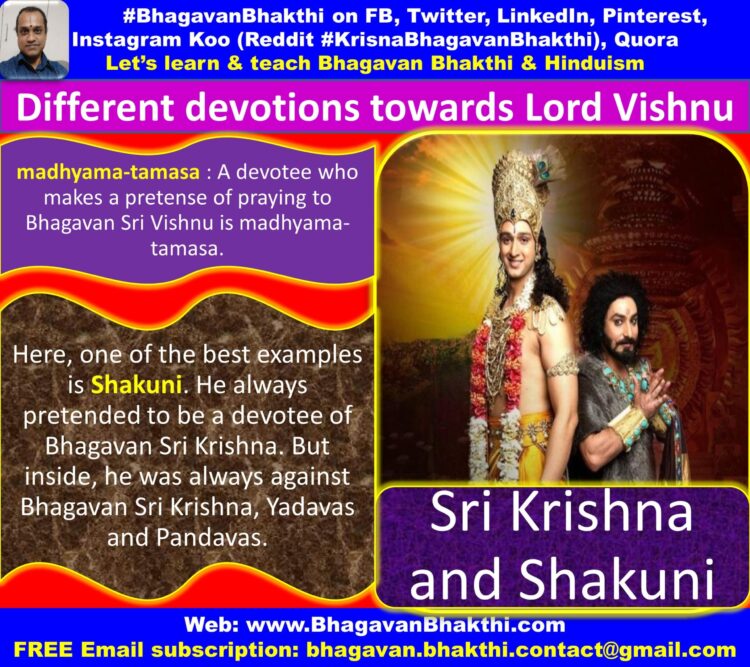
3. uttama-tamasa : A person who picks up devotion to Lord Sri Vishnu by observing others praying is called as uttama-tamasa.
We can give Ekalavya as an example for this. Here Ekalavya observed Pandavas and Kaurvas practicing archery and different weapons. But watching these weaponry, he tried to learn the divine weaponry from Dronacharya.
But, his intentions were always against Dharma. Thus Ekalavya can’t be considered as a correct devotee of Lord Sri Krishna. In the Mahabharata, Ekalavya was the son of Hiranyadhanus, the chief of Nishada.
Ekalavya served under King Jarasandha’s army as General. Ekalavya’s father Hiranyadhanu was the commander of Jarasandha. Both Hiranyadhanus and Jarasandha were arch-rivals of Lord Sri Krishna and Pandavas.
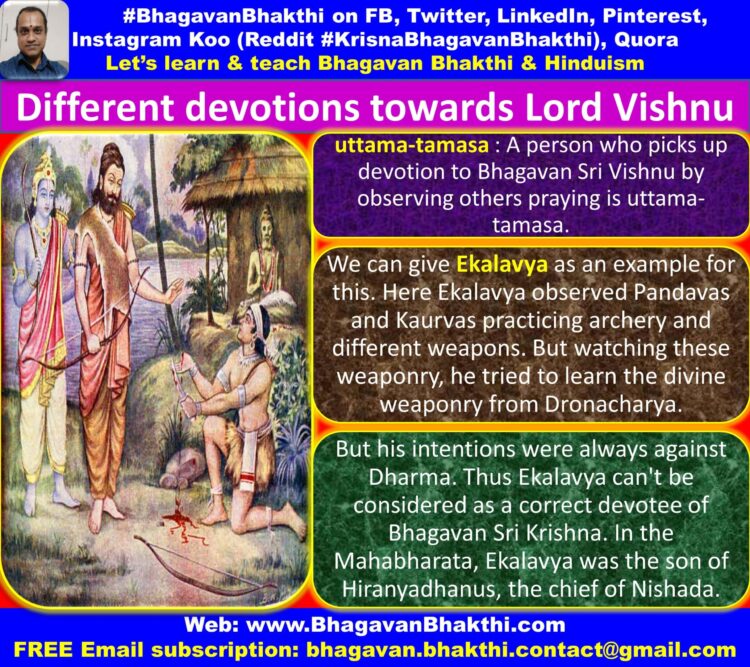
What Dronacharya did was also correct as per the Dharma, as in future Ekalavya and his father Hiranyadhanu had plans to go against Lord Sri Krishna and Pandavas.
To more know about slaying of Ekalavya, please visit the below link:
List of reasons for killing Ekalavya by Lord Krishna
4. adhama-rajasa : An adhama-rajasa devotee claims wealth from Lord Sri Vishnu as a reward for his devotion. Here few examples like Hiranyakashipu, Ravana, etc. can be considered.
Hiranyakashipu does penance to Lord Sri Brahma Deva, so that he will be not be killed by any creatures who take birth from Lord Sri Brahma Deva.
Similarly, Ravana and his two brothers Kumbhakarna and Vibhishana performed penances on Mount Gokarna for about 11,000 years and won rewards from Lord Sri Brahma Deva.
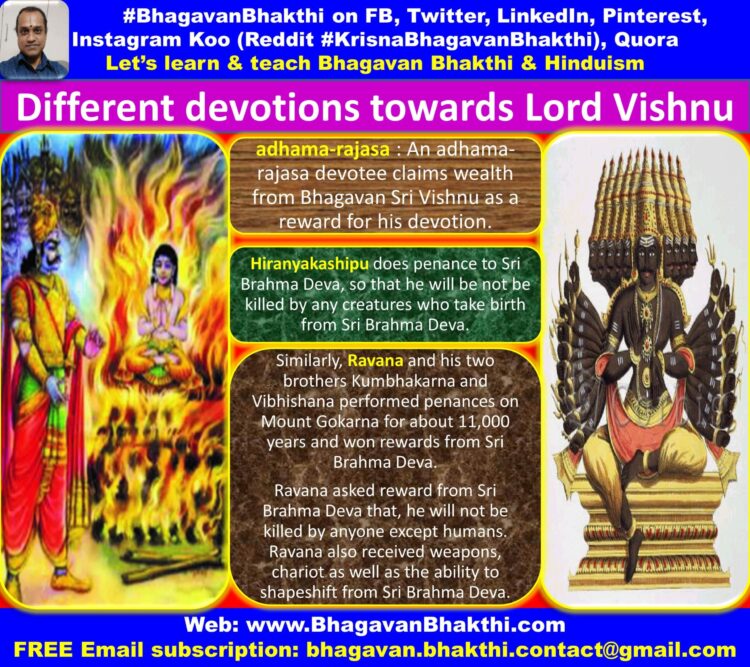
Ravana asked reward from Lord Sri Brahma Deva that, he will not be killed by anyone except humans. Ravana also received weapons, chariot as well as the ability to shapeshift from Lord Sri Brahma Deva.
Later, Ravana completely usurped Lanka from Kubera, who was his own half-brother and became the King of Lanka and thus Ravana was called as Lanka-dhisha.
Ravana also appointed Shukracharya as his head-priest and learned the Artha-Shastra (Science of Politics) from him.
5. madhyama-rajasa : A madhyama-rajasa devotee claims the fame of great deeds.
One of the good examples for this will be Bali Chakravarthy, who was heading all the demons during the samudra manthana (churning of ocean for ambrosia / divine nectar / amrit manthan).
Even though he was a great devotee of Lord Sri Vishnu, but during the samudra manthana he expected deeds from Lord Sri Vishnu. He was wanting amrita (ambrosia / divine nectar) from Lord Sri Vishnu.
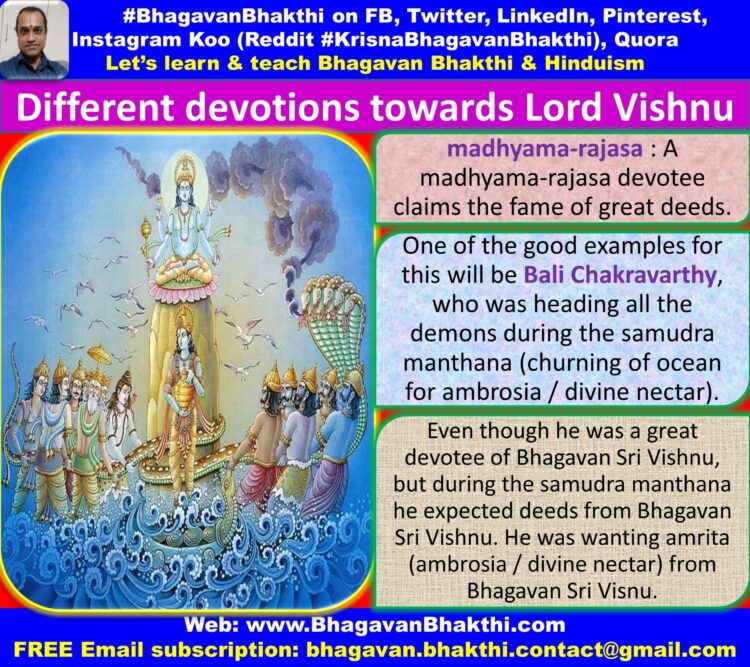
6. uttama-rajasa : An uttama-rajasa devotee desires freedom from all illusions. Very good example for this will be Akrura of the Mahabharata fame.
Akrura means, someone who is not at all cruel. He was one of twelve sons born to Shvaphalka and Gandini. Shvaphalka was a son of Prishni and Gandini was a daughter of the king of Kashi.
In relation, Akrura was an uncle of Lord Sri Krishna, but he is respected more as a worshipper (devotee) of Lord Sri Krishna.
When Akrura was sent by Kamsa, so that he can bring both Lord Sri Krishna and Sri Balarama with him.
Akrura was more than excited to see both, especially Lord Sri Krishna. But Akrura had no expectations and he was free from all the illusions.
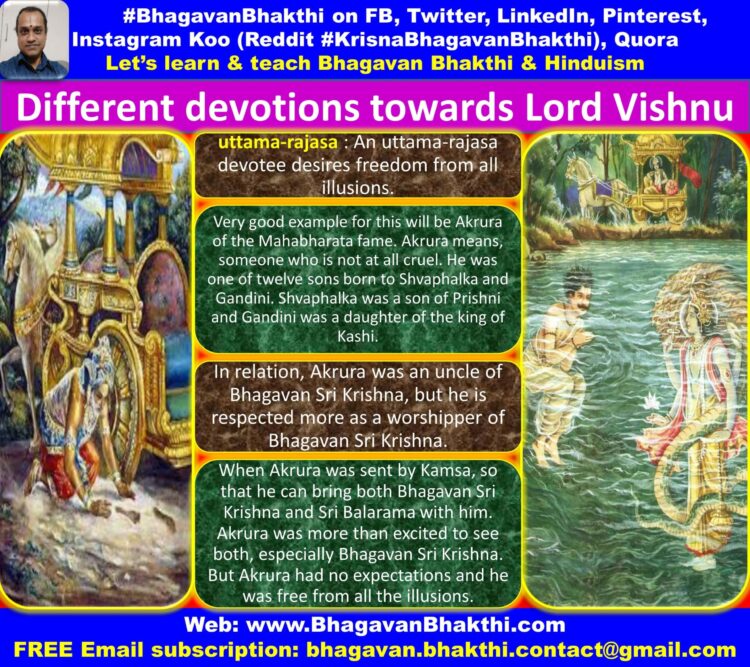
7. adhama-sattvika : A devotee who prays so as to atone for his sins is called an adhama-sattvika.
Superb example for this is the hunchback lady Kubja (Trivakra). Because of her sins in her earlier lives, she was born as a hunchback lady during the Mahabharata period.
Kubja (Trivakra) was doing atonement (प्रायश्चित) in this life. When Lord Sri Krishna visits Mathura along with his elder brother Sri Balarama, he sees this lady Kubja (Trivakra) and calls her as a ‘beautiful lady’.
Later, with the blessings of Lord Sri Krishna, she indeed becomes highly beautiful and also she becomes mother of a child called as Vishoka, whose father is Lord Sri Krishna.
This same Vishoka becomes the charioteer of the great and mighty Bhima during the Mahabharata war.
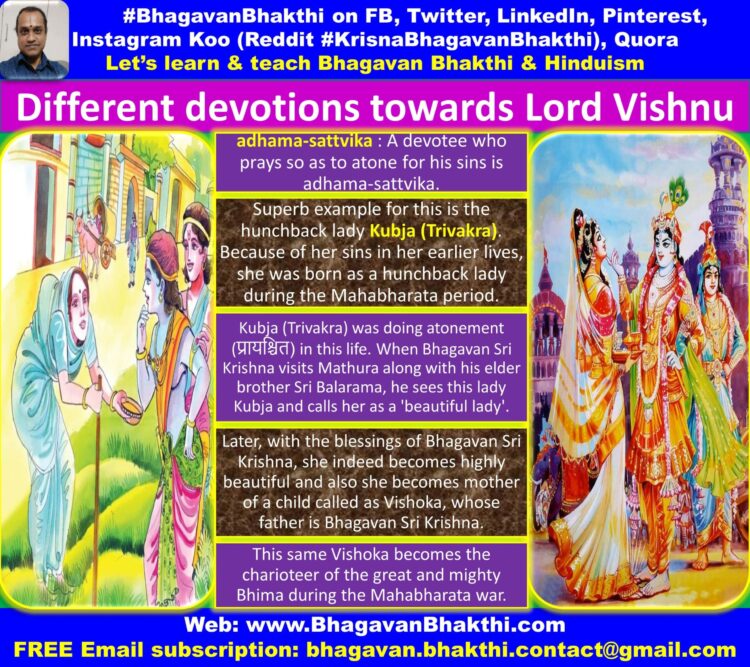
8. madhyama-sattvika : One who prays because such prayers are loved by Lord Sri Vishnu is called as a madhyama-sattvika.
One of the great examples for this is Vidura. Vidura was an avatar of Lord Sri Yama Deva (Yudhishthira was also an avatar of Lord Sri Yama Deva).
Whenever Vidura was praying to Lord Sri Krishna, immediately Lord Sri Krishna was coming in front of Vidura. Such was the devotion of Vidura towards Lord Sri Krishna.
When Bhagavan Lord Sri Krishna comes for negotiation talks before the war of Mahabharata, Lord Sri Krishna stays in Vidura’s house rather than Duryodhana, Karna, Dronacharya, Bhishma, etc. house.
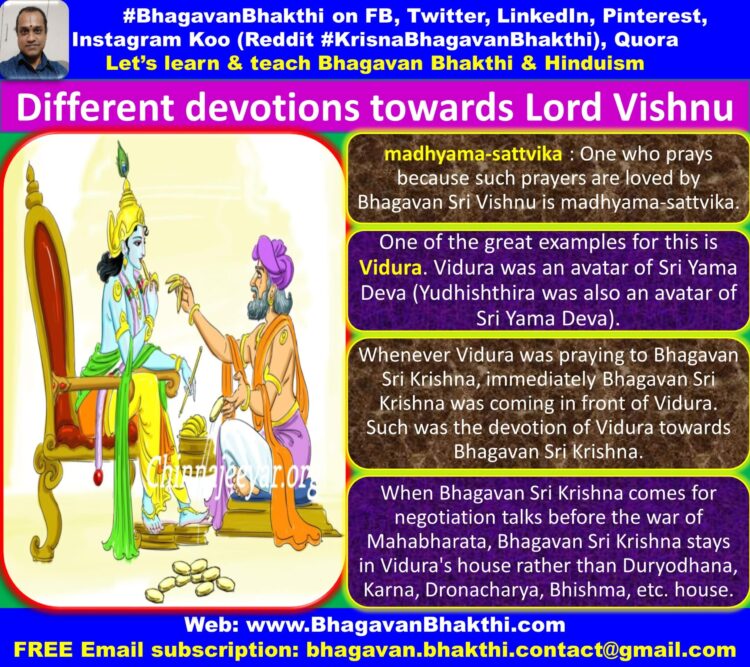
9. uttama-sattvika : A devotee who prays for the sake of devotion alone is called as an uttama-sattvika.
Again, one of the best examples is Sudama Brahmana (Brahmin) in Mahabharata period and during the Ramayana period we can consider Vibhishana as an example.
Vibhishana was always praying Bhagavan Lord Sri Rama and was also chanting Lord Sri Rama name with utmost devotion.
For this reason, Bhagavan Sri Rama allows Vibhishana to be part of his army during the fight against Ravana.
For this reason, Lord Sri Rama makes Vibhishana the king of Lanka. This was the greatness of Vibhishana.
Similarly, Sudama was a great and true devotee of Lord Sri Krishna. As a Brahmana (Brahmin), Sudama was doing all the rituals on daily basis with utmost devotion.
For this reason, Bhagavan Sri Krishna blesses Sudama, his family and also his whole village with sattvika sampath (auspicious wealth).
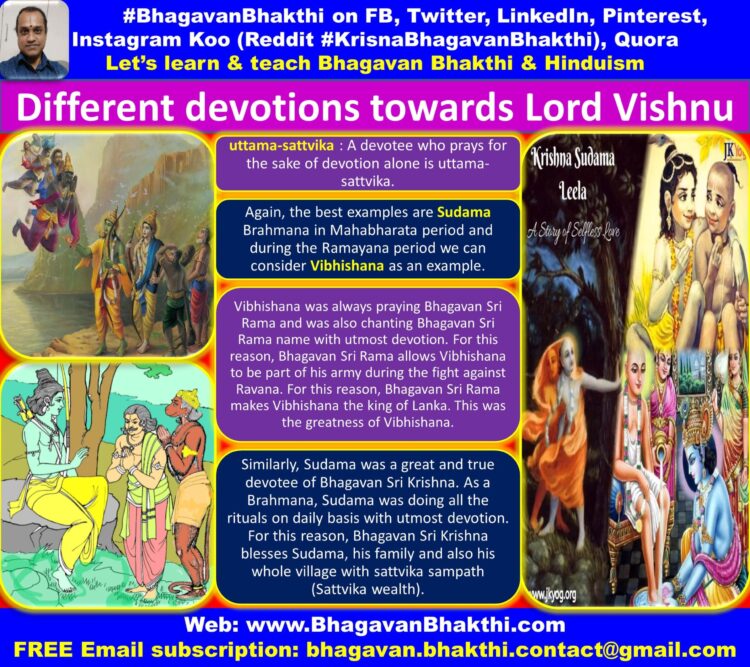
10. uttamottama Bhakti : This list thus has nine different types of devotion to Lord Sri Vishnu. But there is one further type of devotion to Lord Sri Vishnu, and this is the best form of devotion that one can think of.
This is known as uttamottama Bhakti (great-greater devotion) and occurs when the devotee shows the bhakti (devotion) without any expectations.
Greatest example for is Hanuman during the Ramayana period and Bhima during the Mahabharata period. Both Hanuman and Bhima are the avatars of Lord Sri Vayu Deva. Both Hanuman and Bhima are one and the same.
Both never ever went against the words of Lord Sri Rama and Lord Sri Krishna. Both are the ardent devotees of Lord Sri Rama and Lord Krishna. I don’t have any words to describe the devotion of Hanuman and Bhima.
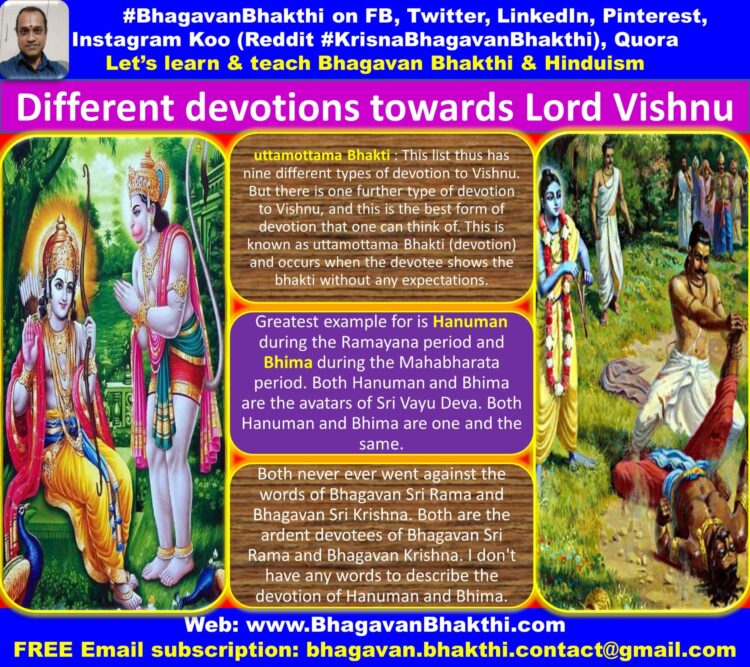
More information will be added to this on regular basis, please visit after some time to know more information.
To watch videos on #Hinduism #Sanskrit language, SUBSCRIBE to my YouTube channel from this below link:
#BhagavanBhakthi YouTube channel
Continue reading to know about “Mahabharata information, facts, significance, importance” from here:
Mahabharata information, facts, significance, importance
Continue reading to know about “Lord Sri Vishnu information (facts) (details)” from here:
Lord Sri Vishnu information (facts) (details)
To watch about “Lord Sri Krishna information” YouTube video, click the below YouTube video link:
Lord Sri Krishna information (YouTube videos)
To read about “Lord Sri Krishna information (website / blog reading)“, please click the below link:
Lord Sri Krishna information (website / blog reading)
Dear friends, if you need any clarifications about this post, kindly let me know, I will definitely try to answer all of them.
Also your one LIKE, one COMMENT, One Share, one SUBSCRIPTION is highly important.
This will help to know the quality of this content and also it will be helpful to know if any improvements is required for the content.
If you feel this content is useful to you and has helped you to improve your knowledge, kindly share this with your well-wishers.
Because “SHARING MEANS CARING”.
To receive FREE EMAIL SUBSCRIPTION about #BhagavanBhakthi, you can send an email to bhagavan.bhakthi.contact@gmail.com from your email ID.
NAMASTE!
Sri Gurubhyo Namaha
Sri Krishnaaya Namaha
Sri Krishnaarpanamastu
Share in Social Media